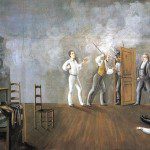The LDS church has purchased the site of the most infamous event of the 1838 Mormon War in Missouri—the site of the Haun’s Mill Massacre. The previous owner of the site, the Community of Christ (formerly known as the Reorganized Church of Jesus Christ of Latter Day Saints), announced the sale of the historic ground in an April 3, 2012 e-mail. Originally approached by the Mormon Historic Sites Foundation about the purchase over a year ago, the Community of Christ eventually sold Haun’s Mill and three other historic properties to subsidiaries owned by the LDS church for $41.5 million. [1] The news of the Haun’s Mill sale has generated a fair amount of interest from the members of the many churches descended from Joseph Smith, Jr.’s restoration movement. [2] While the physical site of Haun’s Mill now resembles a rather unremarkable farmer’s field with several small memorial markers dotting its landscape, as a massacre site, it constitutes a piece of America’s “shadowed ground,” or a place of violence and tragedy that has been “sanctified” by a community. [3] A piece of shadowed ground, like a massacre site, invites any number of narratives about it as people try to make sense of the events once enacted there. Due to the “surplus of meaning” that people assign to it, a massacre site may occupy the same physical space but be a very different place for varying groups and individuals. The Mormon churches in particular have “created” very different Haun’s Mills as they have used the site to illustrate strikingly different church teachings.
Take two recent examples. In 2008, LDS Apostle and First Counselor in the First Presidency Henry B. Eyring recounted that “when tensions ran high in northern Missouri in the fall of 1838, the Prophet Joseph Smith called for all the Latter-day Saints to gather to Far West [Missouri] for protection. . . He specifically counseled Jacob Haun, founder of a small settlement called Haun’s Mill.” Eyring noted that Haun failed to follow Smith’s orders to move his group. As most in Eyring’s readership well knew, Jacob Haun’s small community was overwhelmed by a force of 200 Missouri militia men who marched into the Northern Missouri settlement on October 30, 1838. After facing off with the militia for a few eerie moments, Mormon men and boys ran to hastily defend their community. The Mormons were summarily gunned down, even after attempting surrender. Seventeen Mormons died at Haun’s Mill; their grief-stricken family members buried their bodies in an unfinished well on the site. [4] In Joseph Smith’s official church history, the founding prophet stated after the massacre that, “Up to this day God had given me wisdom to save the people who took counsel. None had ever been killed who abode by my counsel.” Eyring quoted this statement in his 2008 article and then added that “the Prophet [Joseph Smith] recorded the sad truth that innocent lives could have been saved at Haun’s Mill had his counsel been received and followed.” [5] While individual LDS members may take issue with Eyring’s interpretation of the causes of the massacre, his narrative illustrates a general LDS need, in 1838 and now, to explain the horror of the massacre within a universe where a providential God orders all things, directs God’s servants, and people suffer by their disobedience to such authorities.
In contrast to Eyring’s use of the massacre as a lesson about obedience to God’s servants, Community of Christ Apostle Andrew Bolton stated in a 2009 documentary that “two days before the massacre they [the residents at Haun’s Mill] reiterated their commitment to live in peace with their neighbors. This was a genuine, authentic group that didn’t want any part of the violence and suffered horrible tragedy. [The violence, Bolton notes, was committed by some members of the Mormon church hierarchy, Mormon militia men from other areas, non-Mormon Missouri militia men, and some Missouri state officials in the days before the massacre.] The lesson from Haun’s Mill is the innocent get hurt whenever there is human violence. It spills over, and there is tragedy.” [6] For Bolton, Haun’s Mill serves as a cautionary tale about the tragic consequences of humans taking up the sword against their neighbors. Combatants do not just suffer. Those caught between the combatants inevitably suffer, too. It is a lesson fit for the contemporary Community of Christ’s mission of promoting “communities of love, hope, joy, and peace.” Apparently, though, with a strained denominational budget and a shrinking North American membership, it is a lesson that will not be told onsite by the Community of Christ in the future.
To borrow terms from Heraclitus and Thomas Tweed, as no one can step into the same river twice, no one can step into the same historic site twice, too. [7] Places are necessarily social and transformed from space to place by people through stories. And those narratives have different strategic uses. In this way, places always change as stories about them and the interest groups that visit them change. Haun’s Mill, like all significant historic sites, has been made by the narratives people tell about it. Now that the LDS church possesses the massacre site, I think it is unlikely that LDS General Authorities (leaders in the highest levels of church administration) will continue to tell “the disobedience to counsel” story about Haun’s Mill. Why invest millions of dollars to buy a site if it is simply an example of how people disobeyed the voice of God’s anointed? There are certainly other narratives about Haun’s Mill that LDS church officials have used in the past beyond the disobedience narrative. For instance, contemporary adult Sunday school materials in the LDS church place Haun’s Mill squarely within a persecution narrative that portrays innocent Northern Missouri saints suffering at the hands of rapacious, violent Missouri mobs. This is a story of the Haun’s Mill Mormons as martyrs.[8] We might speculate if the Community of Christ’s narrative of the dangers of warfare on the innocent will crossover into LDS interpretation of the site in the future. Liberal churches, like the Community of Christ, do poorly in America, but liberal ideas are wonderfully successful, so say a few sociologists.[9] We shall see. For the present, the LDS church has no plans to physically develop Haun’s Mill as it has done with other Mormon historic sites. [10] However, that will not stop Mormon groups from producing new narratives about the site. Such new narratives will inevitably continue the creation of multiple Haun’s Mills, even as the physical space remains a small muddy field in Northern Missouri.
[1] The other sites included in the sale were the Far West, Missouri burial grounds; the unrestored Joseph Smith, Sr. and Lucy Mack Smith home in Kirtland, Ohio; and 6,000 acres of farm land in Jackson County, Missouri. Of the $41.5 million from the sale, more than $9 million will be placed in an endowment to preserve existing Community of Christ historic properties in Kirtland, Ohio and Nauvoo, Illinois. Steve Veazey and Steve Jones, e-mail to Community of Christ staff, in possession of the author, April 3, 2012.
[2] For instance, see the comments here on a Deseret News article about the sale.
[3] Kenneth E. Foote, Shadowed Ground: America’s Landscapes of Violence and Tragedy (Austin: University of Texas Press, 2003).
[4] For two scholarly accounts of the massacre and its causes, see Stephen C. Leseur, The 1838 Mormon War in Missouri (Columbia, Missouri: University of Missouri Press, 1988), 162-168 and Thomas M. Spencer, “ ‘Was This Really Missouri Civilization’: The Haun’s Mill Massacre in Missouri and Mormon History,” in The Missouri Mormon Experience, ed. by Thomas M. Spencer (Columbia, Missouri: University of Missouri Press, 2010), 100-113.
[5] Henry B. Eyring, “Safety in Counsel,” Ensign, Jun 2008, 4-9.
[6] Andrew Bolton, as quoted in Trouble in Zion (2009).
[7] With some modification, I’m borrowing this idea from Thomas A. Tweed, America’s Church: The National Shrine and Catholic Presence in the Nation’s Capital (New York: Oxford University Press, 2011), 241.
[8] Patrick Q. Mason, The Mormon Menace: Violence and Anti-Mormonism in the Postbellum South (New York: Oxford University Press, 2011), 153, 233 n.8.
[9] Mark Chaves, American Religion: Contemporary Trends (Princeton: Princeton University Press, 2011), 92-93.
[10] Jamshid Ghazi Askar, “LDS Church Buys Farmland, Haun’s Mill, Far West, Kirtland Property from Community of Christ,” Deseret News (5 May 2012).











